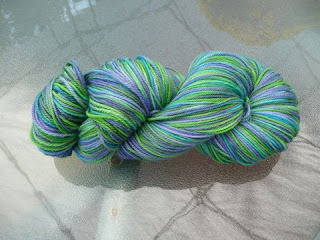
We were each given three types of yarn: a sock yarn, 100% blue-faced Leicester wool and 100% seacell. The yarn had to first be soaked for about an hour in Synthrapol, an agent that opens up the fibres and allows the water to penetrate the yarn completely. After pressing the water out we laid the damp yarn on Saran Wrap and selected our colours to start hand-painting it.
My first attempt was painting the sock yarn with kelly green, violet, sky blue and a few splashes of turquoise which was in limited supply.

We used foam craft brushes to literally paint the yarn.
For the blue-faced Leicester wool, I used orange, kelly green and yellow.
On the seacell, I used sky blue, violet and spruce.
Once finished 'painting', we then rolled up the yarn in the Saran Wrap lengthways and then rolled up the long tube like a jelly roll and put it in Ziploc bags. The Ziploc bags are then put into a big pot and steamed for an hour to set the dye.

During this time, we were served a delicious lunch catered by the Tin Mill Restaurant.
After our yarn was steamed, it was removed from the bags and cooled down. Then the hanks were given a rinse in sythrapol again to remove any residual dye that had not adhered to the fibres. Then the water was again pressed out of the yarns.
Here is what mine looked like at this stage.

We were told to rinse the yarn once more at home with Dawn to make sure the last bits of residual dye were rinsed free and rinse again in clear water with vinegar to set the dye one last time.
Here we all are with our beautiful yarns.

After the final rinses, it took a while for my yarns to dry. I then rewound the yarn into a skein to show off the blending of the colours.

This is my beautiful sock yarn.
The whole process was lots of fun but I now have a greater understanding why hand-painted yarns are more expensive.
Now for the perfect sock pattern.....

Wow...great dye job...your sock yarn looks beautiful!
ReplyDeleteCan you dye seacell with acid dyes?
Yes, we used acid dye on the seacell.
ReplyDelete